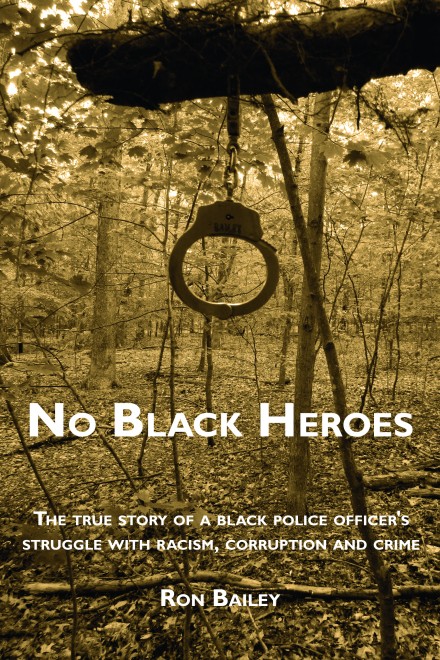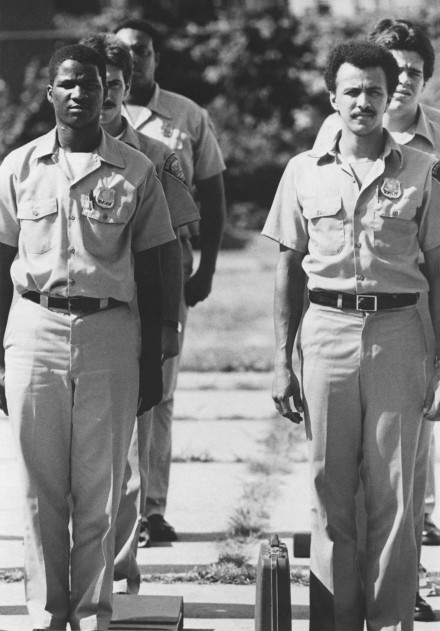
Retired Bridgeport Police Lieutenant Ron Bailey is one of a kind, for sure. He battled bad guys, establishment guys, police chiefs and racism. He investigated, infiltrated and broke up sinister gangs. Most of us duck verbal slings and arrows. Bailey ducked gunfire that was intended for him. Four years ago, after 30 years on the job, he retired to share his law enforcement career in college classrooms and immerse himself into his newly released book, No Black Heroes that chronicles struggles with racism, corruption and crime.

Bailey, a decorated police officer and martial artist, is an interesting study, someone who can walk the streets with common folks or gab intellectually about a variety of subjects. He has also suffered deeply–and tragically–on a personal level with family as father and grandfather. The stuff he has endured would break many.
For years he has itched to release his book, all 500 pages of it, to share insight into “what’s it really like to be an African American police officer, how drug gangs like The Number One Family, Frankie Estrada and the Terminators, the Jones, and others were infiltrated and shut down … the racism we are forced to deal with, the community, the police departments, and its effects … And yes, people did try to have me killed.”
It was a cathartic process for Bailey in a book packed with stories: the racism of his youth, career path, the shootings, the threats, courtroom drama, 18 years undercover work against drug gangs with a nod also to officers “instrumental in my survival, the safety of my family and my rise in rank” such as David Daniels and Ted Meekins, both also retired from the city but still involved.
Meekins was a pioneer in petitioning federal courts more than 30 years ago to address racial discrimination in the Police Department, be it hiring practices, testing procedures, deployment and promotions. Similar issues plagued the Fire Department as well, that required court resolution.

As a result of his experiences, Bailey writes, “every police officer can benefit from reading about the struggles of black officers, their relationships with white officers, and the stories about the unanswered calls for justice from the communities they serve.”
Teaser from Bailey’s book:
What is it like to be a black police officer in America? How do we as African American officers serve our communities that, in many ways, hate us? What does it feel like to be distrusted by the very culture you came from? And how can we address the hatred of those in policing who don’t want us involved in law enforcement?
When Bailey retired four years ago, he shared with OIB some police work highlights:
1. The first day I was sworn in as a police officer. My son and I ended up with our picture in the papers, he was just nine months old.
2. Surviving my first of six shoot-outs in 1986, Eric Williamson. As a result of his having a semi-auto 15-shot handgun compared to our then six-round revolver (of which I ran out of ammo), the department realized we had to have more firepower and brought us in Berettas.
3. Being the first officer to arrest a key member of the Number 1 family, Big Red William Giusti on Clinton Ave. It helped [Billy] Chase to develop a major case and bring them completely down later on.
4. Being responsible for convincing key members of the Jones family from P.T. Barnum who turned state’s evidence and closing down that drug faction, along with the Terminators and Frankie Estrada. The Feds were able to link the two due to key evidence I seized in that case.
5. Taking down members of the Latin Kings who went after a fellow police officer’s family, Officer Ernie Garcia. They tried to set his father’s car on fire because he lived across the street from Marina Apartments which was a drug-infested location. We came in and took down the whole thing.
6. One other, last year I collected so much toiletries, food and clothing for the homeless shelters in Bridgeport, I had to send the extra supplies to the New Haven homeless shelters. I also received donations and supplies for Prospect House to provide them with a computer so the residents could look for family, jobs, and submit application for work on line.
To learn more and order Bailey’s book see here.


Thank you for your service Mr. Bailey?
Brother Bailey, thank for your service and I would like to thank Ted Meekins and others for their leadership for pushing the door open for black and Hispanic to become firefighters but sadly there are those of our own who think that they got there on there own. Ron, it’s great that even after dealing with the ills of society that most citizens run from people don’t know the harm it does to you and your family and to other police officers but how God plays such powerful place in your life.
Teaser from Bailey’s book:
What is it like to be a black police officer in America? How do we as African American officers serve our communities that, in many ways, hate us? What does it feel like to be distrusted by the very culture you came from? And how can we address the hatred of those in policing who don’t want us involved in law enforcement?
Is it possible that by sharing the story of one man’s journey, vocation and other, that misunderstandings and automatic responses, can at least be dampened? Where can we, or better yet, when do we address the questions raised and the “supremacist attitudes” exposed. They do not make for community safety. It is easy to point them out at the top, and when it is as blatant as happens today, the top wobbles and may “topple” even though there is a percentage with roots so deep they cannot even identify where the emotion comes from which frames the way they see life and where skin color is a major factor.
Recently I read CALLED TO RISE written by retired Dallas Police Chief David O. Brown. His rise in the department, the opportunities, the challenges and the deaths that were part of the fabric of his community service are another story that can inform us and broaden community understanding for the fact that “reconstruction” is ongoing and necessary, because it has never been allowed to play out without obstruction and variations of Jim Crow surfacing and in play. Who will provide safe room and time for such community discussion? Time will tell.
In today’s climate where there is more distrust of the police especially in the cities. How do people see Black cops or do people see them as cops who are Black?
I would imagine most people see a Black cop as just another cop.
Cops are all trained the same but they do not go about their daily business the same. I would imagine this holds true no matter what color they are.
As people we all have a story or two it’s only when we get to meet someone new is when we fine what we have in common. I believe most of us have more in common than we know.
I have heard of stories about the Bridgeport Police Department and it’s history of racism. This is why the Guardians were formed and a special Master appointed to oversee the department. Sounds ironic using Master and oversee too.
Police departments are microcosms of society and where there are people there will be bias to color both Black and White,it is not avoidable.
WTF, that cover looks like a Noose hanging from a tree. Was Bailey the only black cop who doesn’t fear anything resembling a noose? Years writing the book and he couldn’t come up with a better title and cover? I’ll wait for the Jimmy Honis book.
Wait a little, Joel. Marvel Comics will publish sn illustrated version.
All of us(USA) do need to engage and have an open discussion about racism.
The racism in this country starts at the top, the White House. When white nationalists assaulted counter protesters in Charlottesville, Virginia, earlier this year 45 said they are sime “very nice guys” among the skinheads and klansmen and neo nazi sympathizers. When African-American professional athletes dropped to one knee during the national anthem to protest racism he called one of them “a son of a bitch” that should be fired. That is a clear indication where Mr. Trump’s sympathies lie.
Racism like other learned behavior is taught at home. You take a mixed group of toddlers none of them know the difference between the other toddler or the economic status of the parents.
It is only when it is pointed out to them and that starts with the color of skin. Unless the child is allowed to make up his or her mind about people, the child will grow into an adult keeping the opinion what he or she was taught about people who look different then them.
Any cop who is racist no matter what color they are can not say their fellow Officers are okay just because they are wearing the same uniform.